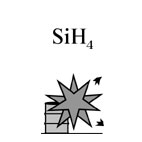| Case Name |
Explosion caused due to mixture of nitrous oxide gas with mono-silane gas at university |
| Pictograph |

|
| Date |
October 2, 1991 |
| Place |
Toyonaka, Osaka, Japan |
| Location |
Laboratory in a university |
| Overview |
On October 2nd, 1991. During an experiment using mono-silane gas in the laboratory of a university, the mono-silane cylinder exploded and ruptured, killing two and injuring five. Nitrous oxide was contaminated in the mono-silane cylinder through a purge line, and a combustible gas-air mixture was generated, which exploded. It was an important point that the type of check valve installed in the purge line could not function with nitrous oxide. |
| Incident |
Explosion occurred during an experiment using plasma CVD equipment in the laboratory of a university. Two students died, and five persons received light injuries.
Mono-silane gas is a gas with a serious risk of spontaneous ignition. |
| Processing |
Research and Development |
| Process Flow |
Fig2.Unit process flow
|
| Substance |
Silane, Fig3 |
| Type of Accident |
Explosion, fire |
| Sequence |
On October 2nd, 1991, 16:00. Students carried out an experiment in which a silicon film was formed on a lithium niobate crystal using plasma CVD equipment. An explosion occurred in the mono-silane cylinder, the cylinder ruptured, a blast wave was generated and debris was scattered. Two students died and five persons were injured. City gas and an organic solvent were ignited by this explosion, and a fire occurred. |
| Cause |
Mono-silane and nitrous oxide were supplied to plasma CVD equipment. The supply piping had been separated. However, each purge line was in common use. Therefore, the cylinders of mono-silane and nitrous oxide were connected through the purge line. A check valve was mounted in the purge line, but, it was out of order at the time of the accident. It was considered that the nitrous oxide gas passed through the purge line, entered the mono-silane cylinder, and mixed to generate a combustible gas-air mixture. As for the ignition cause, the following are considered: Temperature rise due to compression related to valve operation and catalysis of metallic material, etc. |
| Countermeasures |
The suitability of the equipment such as check valves for the gas operated is sufficiently checked beforehand. Purge lines of gases, which can react with each other, must be separated. |
| Knowledge Comment |
The purge line for gases that react dangerously with each other should be separated. It is necessary to sufficiently check beforehand that a check valve type and its material are suitable for the gas operated.
Many of particular gases used for manufacturing semiconductors are dangerous. A person without knowledge of handling such gases should consult with a specialist. |
| Background |
A check valve prevents backflow. However, in some cases, it is difficult to prevent backflow perfectly with only one check valve. The block valve must be closed to completely prevent backflow. In addition, it was found from the accident investigation that a check valve of this type cannot be used for nitrous oxide. The main cause of the accident was that proper handling had not been learned before using a new material. A purge line used for combustion supporting gas (nitrous oxide) must not be used for combustible gas (mono-silane). There might be a fire in the piping if both gases are used at the same time. Operators were students of the electronics department, who were not familiar with the handling of chemical substances such as nitrous oxide and mono-silane. It is considered that there were some problems in the management system which left the facilities improperly designed. |
| Sequel |
The high-pressure gas control law was revised after this accident. A person who uses a special high-pressure gas such as mono-silane has to submit a notification to the local government. |
| Incidental Discussion |
The valve could not stop the flow. At the check valve, a leakage occurred from the high-pressure side to the low-pressure side. Unfortunately these problems often happen. |
| Reason for Adding to DB |
Example of major accident due to special high-pressure gas |
| Scenario |
| Primary Scenario
|
Insufficient Analysis or Research, Insufficient Prior Research, Properties, Material for Use, Organizational Problems, Poor Management, Slackness of Management, Planning and Design, Poor Planning, Poor Design, Malfunction, Poor Hardware, Check Valve Leakage, Bad Event, Thermo-Fluid Event, Reverse Flow, Secondary Damage, External Damage, Explosion, Bodily Harm, Death, 2 person died, Bodily Harm, Injury, 5 person injured, Loss to Organization, Economic Loss, Laboratory Burnt and Water Damage
|
|
| Sources |
High Pressure Gas Safety Inst. of Japan. Intermediate report by O university mono-silane gas explosion investigation committee (1992)
High Pressure Gas Safety Inst. of Japan. High-pressure gas protection overview. pp.173-174, 198-199(1992).B18
Monosilane gas explosion during experiment in a university. October 1991 Osaka prefecture. Major accidents in the twentieth century showing on photographs. Safety Engineering No.114. p.16(2001).
|
| Number of Deaths |
2 |
| Number of Injuries |
5 |
| Physical Damage |
49 square meters of a laboratory and adjacent 150 square meters of laboratories burned down. Many laboratories were damaged by water. Facilities and piping for experiment were damaged severely. |
| Multimedia Files |
Fig3.Chemical formula
|
| Field |
Chemicals and Plants
|
| Author |
DOBASHI, Ritsu (School of Engineering, The University of Tokyo)
TAMURA, Masamitsu (Center for Risk Management and Safety Sciences, Yokohama National University)
|
|